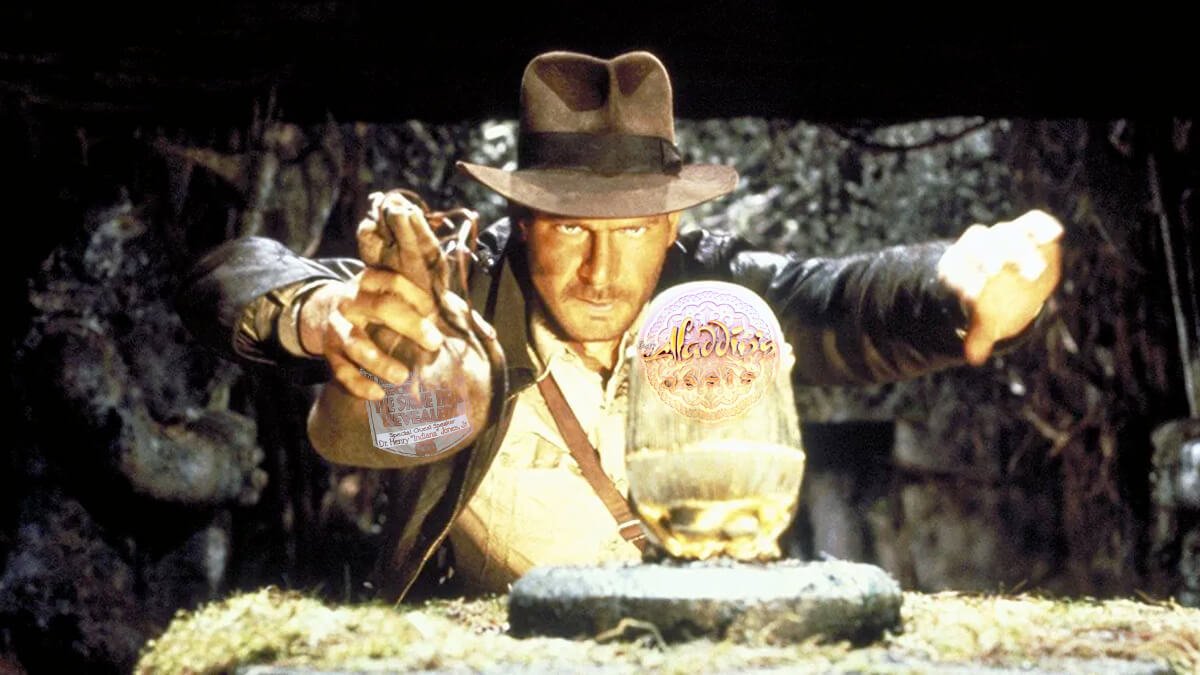
Be sure to check out Part One: How Did We Get “Aladdin’s Oasis” at Disneyland?
The Tahitian Terrace – a Polynesian-themed restaurant which had operated in the Adventureland section of Disneyland Park for 30 years – was shut down in the Spring of 1993 to “ … make way for Prince Ali.”
“Aladdin’s Oasis” (the dinner adventure) only operated for 14 months. This show closed in August of 1994.
“Aladdin’s Oasis – The Restaurant”
Just to clarify here, though. The “Aladdin’s Oasis” show closed after a brief 14 month run . But because the Park had spent so much money building this new Adventureland restaurant (Remember it had been a rush job – going from concept to throwing open its doors in just 5 months – on Michael Eisner’s expressed orders) … That – in an effort to recover some of that money – “Aladdin’s Oasis” ( in 1995 ) re-opened as just a restaurant in Adventureland that didn’t offer a show. People oohed & aahed at all the exquisite detail inside (the in-laid ceramic tiles in the floor. That 15 foot-tall tiger’s head that sat at the center of the stage at the front of this restaurant. FYI: This served as the Cave of Wonders in the “Aladdin’s Oasis” show).
This Adventureland restaurant was admittedly a beautiful venue. But Disneyland visitors in the mid-1990s weren’t all that adventurous. At least when it came to food. And a restaurant that served Americanized Middle Eastern fare had trouble attracting customers back then. Which is why the only-a-restaurant version of “Aladdin’s Oasis” closed in 1995 .
The way theme parks operate financially … Well, Disneyland couldn’t just tear “Aladdin’s Oasis” down and start anew. They’d spent far too much money building the thing. Strictly for tax purposes, this big chunk of Adventureland real estate now had to just sit there, empty as it depreciated.
“Storytime with Aladdin & Jasmine”
Disneyland would periodically try & find other uses for this space. For a time, there was a “Storytime with Aladdin & Jasmine” show staged inside of this now vacant restaurant. Two Cast Members dressed as Aladdin & Jasmine would first tell the story of the “Aladdin” movie. Then – as this show’s finale – the Cave of Wonders would suddenly come roaring to life. And – in a puff of smoke – the Genie would magically appear by leaping out of this giant stone tiger’s open mouth. And then … Well, it was time for the Guests to line-up and get their picture taken with these three characters from “Aladdin.” Maybe grab an autograph or two.
But “Storytime with Aladdin & Jasmine” was only presented at the Park on a seasonal basis. Only during those times of year that Disneyland was busiest. For the most part, this Adventureland eatery stood empty for the better part of a decade. Until word came from Lucasfilm in 2007 that they were about to begin production of a new “Indiana Jones” film.
Indiana Jones Back in Theaters and Promotion at Disneyland
Given that the previous “Indiana Jones” film (i.e., the third in the series, “Last Crusade”) had come out back in May of 1989 … To finally be getting a new “Indy” film after 18 years was a very big deal.
FYI: The gap between the release of the fourth filmin the series (i.e, 2008’s “Kingdom of the Crystal Skull” and “Indy” film No. 5(i.e., 2023’s “Dial of Destiny”) is almost as long. 15 years & change.
Given that Disneyland obviously had its “Indiana Jones Adventureland” attraction (which opened in March of 1995 ) … Well, they saw the upcoming release of “Indiana Jones and the Kingdom of the Crystal Skull” as a synergistic opportunity. So Disney reached out to Lucasfilm and proposed a bit of cross promotion that would involve Disneyland Park.
Just to be clear here: This was back in late 2007 / early 2008 . The Walt Disney Company’s acquisition of Lucasfilm wouldn’t happen ‘til October of 2012 . That’s more than 4 years off in the future .
Translation: It was Lucasfilm – with the highly anticipated movie that Disney now wanted to capitalize on — that had all of the power in this situation. NOTthe Mouse. Keep that in mind as we move ahead with our story here.
“Indiana Jones and the Secret of the Stone Tiger” – Disneyland Show
Anyway … In March of 2008 , Disneyland announces that it will be holding auditions for a new show that will soon be presented in the Adventureland section of that theme park. They’re looking for performers with stage combat experience to fill the following roles:
- Indiana Jones: Male, 40’s; a rugged adventurer, great physical shape; can play drama, toss off comic lines and throw a punch all with equal ability; must interact well with children.
- An archaeologist: Female, late 20’searly 40’s; English accent; starts out kind and helpful but eventually reveals a villainous side; will interact with children and lead them through a series of activities.
- The Bad Guy: Male; imposing stature; physical agility and stamina a must; pursues Indiana Jones through the crowded streets of Adventureland, ending in a series of balcony and rooftop confrontations.
This supposedly kid-friendly attraction – which goes by the name “ Indiana Jones and the Secret of the Stone Tiger” – is supposed to be alive-action adventure that will be staged several times a day all over Adventureland. The idea here is that – over the Summer of 2008 (coming right on the heels of the theatrical release of “Indiana Jones and the Kingdom of the Crystal Skull.” In fact, this new show at Disneyland would begin presenting performances at that Park on the very same day “Indiana Jones 4” was released to theaters. Which – again – was May 22, 2008 ) – Disneyland Guests could join Doctor Jones and solve mysteries, battle evil villains and uncover ancient mysteries.
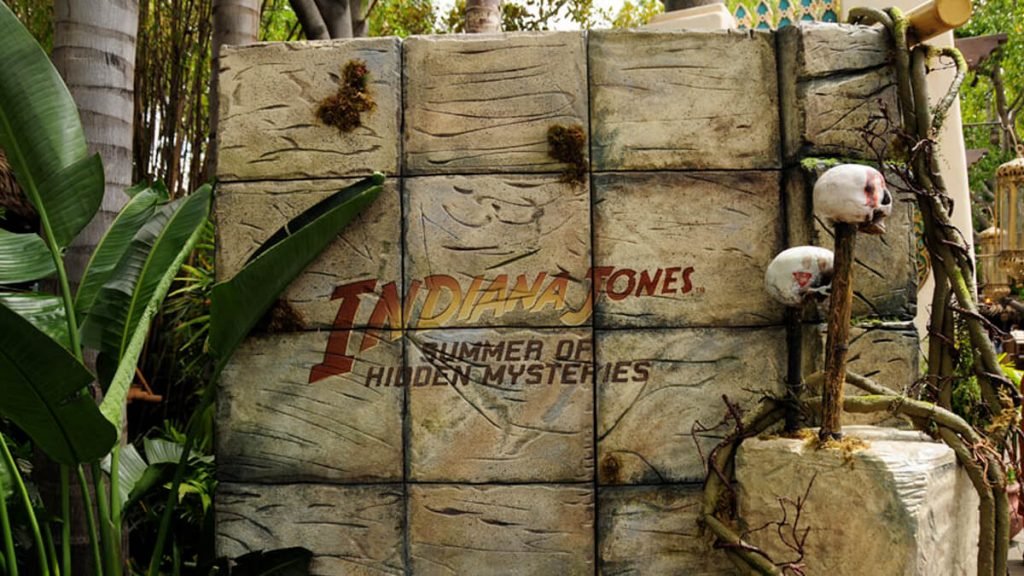
On paper, this three month-long cross promotion (which – because it was only going to held at Disneyland over that theme park’s Summer months – went by the title of “Indiana Jones Summer of Hidden Mysteries”) was a great idea. In their heart of hearts, the Entertainment team at Disneyland Park was hoping that the centerpiece of this three month-long seasonal event (That would be the “Indiana Jones and the Secret of the Stone Tiger” show. Which we’ll get to in a moment) would be such an enormous success that they’d then be able to turn this kid-friendly show into a permanent attraction at Disneyland Park.
Indiana Jones Themed “Jedi Training Academy”
Let me explain what was really going on here: Disneyland’s Entertainment team was hoping that they’d be able to turn the “Indiana Jones and the Secret of the Stone Tiger” show (which – given its title – was obviously going to be staged inside of the now-empty “Aladdin’s Oasis” with that 15-foot-tall version of the Cave of Wonders serving as the centerpiece of this show) into another “Jedi Training Academy” -like show.
Just so you know: The “Jedi Training Academy” started out as a kid-friendly offering at the very first “Star Wars Weekend” at Disney-MGM in February of 1997 . This show was so hugely popular with the under-10 crowd that it was eventually pulled out of this seasonal event at the Parks and turned into an audience-participation experience that was then offered multiple times at Disney’s Hollywood Studios as well as out in Anaheim at Disneyland Park.
Anyway … That was the template that Disneyland’s Entertainment team was using. The Jedi Training Academy. So what they were shooting for here was a 15-minute-long audience participation experience themed around the adventures of Indiana Jones that could then be presented inside of the old “Aladdin’s Oasis” restaurant.
Again, a great idea on paper. But harder to pull off in the real world then you might think.
“The Secret of the Stone Tiger” Stage Show Premise
Why? Okay. The villain in the “Indiana Jones and the Kingdom of the Crystal Skull” was Irina Spalko, a Soviet scientist played by Cate Blanchett.
So to keep some sort of continuity between the “Kingdom of the Crystal Skull” movie and “The Secret of the Stone Tiger” stage show, it was decided that the villain of this kid-friendly audience participation show at Disneyland Park would also be a female.
Okay. So this 15-minute-long show would start out with a Doctor Rachel Flannery standing in front of the Cave of Wonders inside of the old “Aladdin’s Oasis” restaurant. Only – according to Rachel – these supposedly long-abandoned ruins were now the Bengalese temple of Sherdil, the tiger-god.
As Dr. Flannery explains, Indiana Jones had recently rediscovered this temple and gone inside. Indy was supposedly searching for the Golden Rod of Sherdil, an ancient object which is rumored to have great mystical power. But it had now been days since anyone had last seen Doctor Jones.
Anyway … Rachel recruits the help of the kids in the audience. And by using various clues scattered around “Aladdin’s Oasis,” they figure out how to re-open the now-sealed temple of Sherdil. Whereupon Indiana Jones comes stumbling out of the Stone Tiger’s mouth clutching the Golden Rod of Sherdil.
As Indy is thanking the kids in the audience for getting him out of that sealed ancient temple, he puts down the Golden Rod of Sherdil. Dr. Flannery now picks it up and seemingly suddenly gets possessed by the demonic spirit of Kartikeya, the Hindu God of War.
Just a quick reminder here: “Indiana Jones and the Secret of the Stone Tiger” is supposed to be a kid-friendly audience participation show for the under 10 set.
Indy now realizes that Doctor Flannery is holding the Golden Rod of Sherdil and is possessed by Kartikeya, the Hindu God of War. He first tries to wrestle this ancient artifacts out of her hands, but Rachel (because she’s possessed by the Hindu God of War) is super-powerful. She punches Indy a few times, so he punches her back.
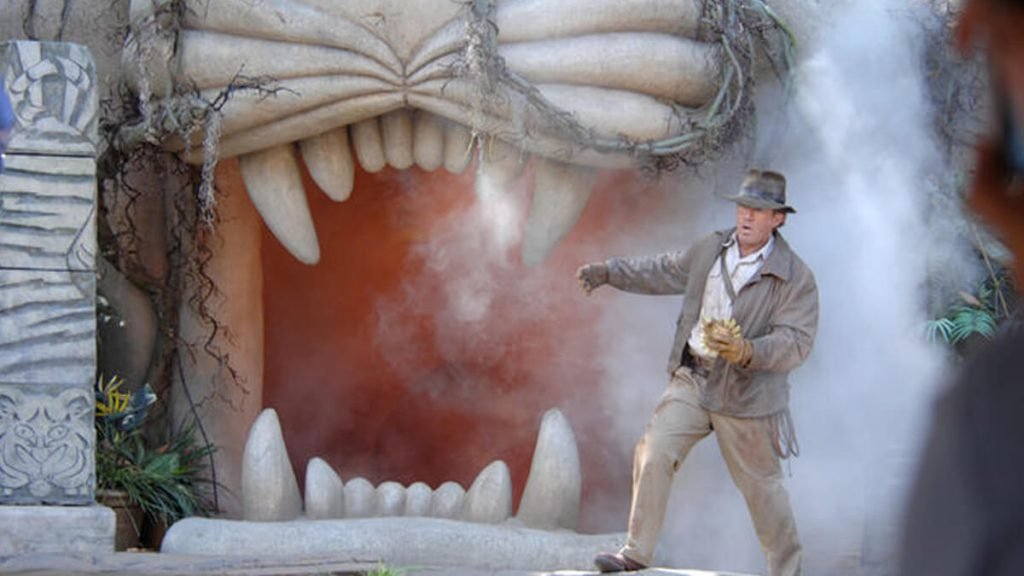
Stage Show Complaints
It was at this point that the mothers of Orange County got upset. That’s a man beating up a woman in a show at Disneyland. To which the Entertainment team at that theme park said “Actually, no. That’s Indiana Jones battling with an fellow archaeologist who’s just been possessed by Kartikeya, the super-powerful Hindu God of War. Indy’s battling with a female character, just like he does in ‘Kingdom of the Crystal Skull.’ Which just opened at a theater near you.”
That explanation didn’t matter. The mothers of Orange County were outraged. They marched en masse to Disneyland’s Guest Relations Department to lodge their complaints. Which is why – just days after the “Indiana Jones and the Secret of the Stone Tiger” show opened at that theme park, in an interview with the Orange County Register – Disneyland’s PR team announced that “Secret of the Stone Tiger” would now be altered. Indiana Jones would no longer throw direct punches at the woman character (Doctor Flannery) in this supposedly kid-friendly show, he would simply dodge.
And speaking of dodging … What also upset the mothers of Orange County (as well as a significant number of Disneyland Guests) was … Well, in the agreement that Disney had cut with Lucasfilm to have the Indiana Jones character appear at that theme park during “The Summer of Hidden Mysteries,” the Cast Member playing Indy was not allowed to meet with park guests in your typical meet-and-greet format. This meant that no one came away with a photo of or an autograph from their favorite archaeologist.
This meant that a lot of little kids walked away from the “Indiana Jones and the Secret of the Stone Tiger” show in tears. Not because Indy beat up the lady. But because Dr. Jones wouldn’t sign their autograph book.
Irony here: Remember that scene in “The Last Crusade” where Indy accidentally bumps into Adolph Hitler at a book-burning rally. And the Fuhrer then signs Doctor Henry Jones, Str’s grail diary.
So sure. Adolph Hitler gives autographs. But not Indiana Jones.
Fate of “The Secret of the Stone Tiger” and “Aladdin’s Oasis” – Disneyland “Tropical Hideaway”
This is why the “Indiana Jones and the Secret of the Stone Tiger” show didn’t become the next Jedi Training Academy. By the Fall of 2008 , the only Indy-related things that was left in Adventureland was the “Temple of the Forbidden Eye.”
More to the point, this is why – some ten years later (after “Aladdin’s Oasis” had experienced enough depreciation that it could now be taken off of Disneyland’s books) – this long-empty Adventureland venue was torn down in early 2018 and then turned into the “Tropical Hideaway.” Which soft-opened in December of that same year .
Kind of appropriate that this new Adventureland eatery soft-opened. Because they serve several different types of Dole Whip here. Along with Bao Buns & Sticky Pork.
Full circle. Kind of back to what the Tahitian Terrace offered.

History
The Evolution and History of Mickey’s ToonTown

Disneyland in Anaheim, California, holds a special place in the hearts of Disney fans worldwide, I mean heck, it’s where the magic began after all. Over the years it’s become a place that people visit in search of memorable experiences. One fan favorite area of the park is Mickey’s Toontown, a unique land that lets guests step right into the colorful, “Toony” world of Disney animation. With the recent reimagining of the land and the introduction of Micky and Minnies Runaway Railway, have you ever wondered how this land came to be?
There is a fascinating backstory of how Mickey’s Toontown came into existence. It’s a tale of strategic vision, the influence of Disney executives, and a commitment to meeting the needs of Disney’s valued guests.
The Beginning: Mickey’s Birthdayland
The story of Mickey’s Toontown starts with Mickey’s Birthdayland at Walt Disney World’s Magic Kingdom. Opened in 1988 to celebrate Mickey Mouse’s 60th birthday, this temporary attraction was met with such overwhelming popularity that it inspired Disney executives to think bigger. The idea was to create a permanent, immersive land where guests could step into the animated world of Mickey Mouse and his friends.
In the early ’90s, Disneyland was in need of a refresh. Michael Eisner, the visionary leader of The Walt Disney Company at the time, had an audacious idea: create a brand-new land in Disneyland that would celebrate Disney characters in a whole new way. This was the birth of Mickey’s Toontown.
Initially, Disney’s creative minds toyed with various concepts, including the idea of crafting a 100-Acre Woods or a land inspired by the Muppets. However, the turning point came when they considered the success of “Who Framed Roger Rabbit.” This film’s popularity and the desire to capitalize on contemporary trends set the stage for Toontown’s creation.
From Concept to Reality: The Birth of Toontown
In 1993, Mickey’s Toontown opened its gates at Disneyland, marking the first time in Disney Park history where guests could experience a fully realized, three-dimensional world of animation. This new land was not just a collection of attractions but a living, breathing community where Disney characters “lived,” worked, and played.
Building Challenges: Innovative Solutions
The design of Mickey’s Toontown broke new ground in theme park aesthetics. Imagineers were tasked with bringing the two-dimensional world of cartoons into a three-dimensional space. This led to the creation of over 2000 custom-built props and structures that embodied the ‘squash and stretch’ principle of animation, giving Toontown its distinctiveness.
And then there was also the challenge of hiding the Team Disney Anaheim building, which bore a striking resemblance to a giant hotdog. The Imagineers had to think creatively, using balloon tests and imaginative landscaping to seamlessly integrate Toontown into the larger park.

Key Attractions: Bringing Animation to Life
Mickey’s Toontown featured several groundbreaking attractions. “Roger Rabbit’s Car Toon Spin,” inspired by the movie “Who Framed Roger Rabbit,” became a staple of Toontown, offering an innovative ride experience. Gadget’s Go-Coaster, though initially conceived as a Rescue Rangers-themed ride, became a hit with younger visitors, proving that innovative design could create memorable experiences for all ages.
Another crown jewel of Toontown is Mickey’s House, a walkthrough attraction that allowed guests to explore the home of Mickey Mouse himself. This attraction was more than just a house; it was a carefully crafted piece of Disney lore. The house was designed in the American Craftsman style, reflecting the era when Mickey would have theoretically purchased his first home in Hollywood. The attention to detail was meticulous, with over 2000 hand-crafted, custom-built props, ensuring that every corner of the house was brimming with character and charm. Interestingly, the design of Mickey’s House was inspired by a real home in Wichita Falls, making it a unique blend of real-world inspiration and Disney magic.
Mickey’s House also showcased Disney’s commitment to creating interactive and engaging experiences. Guests could make themselves at home, sitting in Mickey’s chair, listening to the radio, and exploring the many mementos and references to Mickey’s animated adventures throughout the years. This approach to attraction design – where storytelling and interactivity merged seamlessly – was a defining characteristic of ToonTown’s success.

Executive Decisions: Shaping ToonTown’s Unique Attractions
The development of Mickey’s Toontown wasn’t just about creative imagination; it was significantly influenced by strategic decisions from Disney executives. One notable input came from Jeffrey Katzenberg, who suggested incorporating a Rescue Rangers-themed ride. This idea was a reflection of the broader Disney strategy to integrate popular contemporary characters and themes into the park, ensuring that the attractions remained relevant and engaging for visitors.
In addition to Katzenberg’s influence, Frank Wells, the then-President of The Walt Disney Company, played a key role in the strategic launch of Toontown’s attractions. His decision to delay the opening of “Roger Rabbit’s Car Toon Spin” until a year after Toontown’s debut was a calculated move. It was designed to maintain public interest in the park by offering new experiences over time, thereby giving guests more reasons to return to Disneyland.
These executive decisions highlight the careful planning and foresight that went into making Toontown a dynamic and continuously appealing part of Disneyland. By integrating current trends and strategically planning the rollout of attractions, Disney executives ensured that Toontown would not only capture the hearts of visitors upon its opening but would continue to draw them back for new experiences in the years to follow.
Global Influence: Toontown’s Worldwide Appeal
The concept of Mickey’s Toontown resonated so strongly that it was replicated at Tokyo Disneyland and influenced elements in Disneyland Paris and Hong Kong Disneyland. Each park’s version of Toontown maintained the core essence of the original while adapting to its cultural and logistical environment.
Evolution and Reimagining: Toontown Today
As we approach the present day, Mickey’s Toontown has recently undergone a significant reimagining to welcome “Mickey & Minnie’s Runaway Railway” in 2023. This refurbishment aimed to enhance the land’s interactivity and appeal to a new generation of Disney fans, all while retaining the charm that has made ToonTown a beloved destination for nearly three decades.

Dive Deeper into ToonTown’s Story
Want to know more about Mickey’s Toontown and hear some fascinating behind-the-scenes stories, then check out the latest episode of Disney Unpacked on Patreon @JimHillMedia. In this episode, the main Imagineer who worked on the Toontown project shares lots of interesting stories and details that you can’t find anywhere else. It’s full of great information and fun facts, so be sure to give it a listen!
History
Unpacking the History of the Pixar Place Hotel

Pixar Place Hotel, the newly unveiled 15-story tower at the Disneyland Resort, has been making waves in the Disney community. With its unique Pixar-themed design, it promises to be a favorite among visitors.
However, before we delve into this exciting addition to the Disneyland Resort, let’s take a look at the fascinating history of this remarkable hotel.
The Emergence of the Disneyland Hotel
To truly appreciate the story of the Pixar Place Hotel, we must turn back the clock to the early days of Disneyland. While Walt Disney had the visionary ideas and funding to create the iconic theme park, he faced a challenge when it came to providing accommodations for the park’s visitors. This is where his friend Jack Wrather enters the picture.
Jack Wrather, a fellow pioneer in the television industry, stepped in to assist Walt Disney in realizing his dream. Thanks to the success of the “Lassie” TV show produced by Wrather’s company, he had the financial means to build a hotel right across from Disneyland.
The result was the Disneyland Hotel, which opened its doors in October 1955. Interestingly, the early incarnation of this hotel had more of a motel feel than a hotel, with two-story buildings reminiscent of the roadside motels popular during the 1950s. The initial Disneyland Hotel consisted of modest structures that catered to visitors looking for affordable lodging close to the park. While the rooms were basic, it marked the beginning of something extraordinary.
The Evolution: From Emerald of Anaheim to Paradise Pier
As Disneyland’s popularity continued to soar, so did the demand for expansion and improved accommodations. In 1962, the addition of an 11-story tower transformed the Disneyland Hotel, marking a significant transition from a motel to a full-fledged hotel.
The addition of the 11-story tower elevated the Disneyland Hotel into a more prominent presence on the Anaheim skyline. At the time, it was the tallest structure in all of Orange County. The hotel’s prime location across from Disneyland made it an ideal choice for visitors. With the introduction of the monorail linking the park and the hotel, accessibility became even more convenient. Unique features like the Japanese-themed reflecting pools added to the hotel’s charm, reflecting a cultural influence that extended beyond Disney’s borders.
Japanese Tourism and Its Impact
During the 1960s and 1970s, Disneyland was attracting visitors from all corners of the world, including Japan. A significant number of Japanese tourists flocked to Anaheim to experience Walt Disney’s creation. To cater to this growing market, it wasn’t just the Disneyland Hotel that aimed to capture the attention of Japanese tourists. The Japanese Village in Buena Park, inspired by a similar attraction in Nara, Japan, was another significant spot.
These attractions sought to provide a taste of Japanese culture and hospitality, showcasing elements like tea ceremonies and beautiful ponds with rare carp and black swans. However, the Japanese Village closed its doors in 1975, likely due to the highly competitive nature of the Southern California tourist market.
The Emergence of the Emerald of Anaheim
With the surge in Japanese tourism, an opportunity arose—the construction of the Emerald of Anaheim, later known as the Disneyland Pacific Hotel. In May 1984, this 15-story hotel opened its doors.
What made the Emerald unique was its ownership. It was built not by The Walt Disney Company or the Oriental Land Company (which operated Tokyo Disneyland) but by the Tokyu Group. This group of Japanese businessmen already had a pair of hotels in Hawaii and saw potential in Anaheim’s proximity to Disneyland. Thus, they decided to embark on this new venture, specifically designed to cater to Japanese tourists looking to experience Southern California.
Financial Challenges and a Changing Landscape
The late 1980s brought about two significant financial crises in Japan—the crash of the NIKKEI stock market and the collapse of the Japanese real estate market. These crises had far-reaching effects, causing Japanese tourists to postpone or cancel their trips to the United States. As a result, reservations at the Emerald of Anaheim dwindled.
To adapt to these challenging times, the Tokyu Group merged the Emerald brand with its Pacific hotel chain, attempting to weather the storm. However, the financial turmoil took its toll on the Emerald, and changes were imminent.
The Transition to the Disneyland Pacific Hotel
In 1995, The Walt Disney Company took a significant step by purchasing the hotel formerly known as the Emerald of Anaheim for $35 million. This acquisition marked a change in the hotel’s fortunes. With Disney now in control, the hotel underwent a name change, becoming the Disneyland Pacific Hotel.
Transformation to Paradise Pier
The next phase of transformation occurred when Disney decided to rebrand the hotel as Paradise Pier Hotel. This decision aligned with Disney’s broader vision for the Disneyland Resort.
While the structural changes were limited, the hotel underwent a significant cosmetic makeover. Its exterior was painted to complement the color scheme of Paradise Pier, and wave-shaped crenellations adorned the rooftop, creating an illusion of seaside charm. This transformation was Disney’s attempt to seamlessly integrate the hotel into the Paradise Pier theme of Disney’s California Adventure Park.
Looking Beyond Paradise Pier: The Shift to Pixar Place
In 2018, Disneyland Resort rebranded Paradise Pier as Pixar Pier, a thematic area dedicated to celebrating the beloved characters and stories from Pixar Animation Studios. As a part of this transition, it became evident that the hotel formally known as the Disneyland Pacific Hotel could no longer maintain its Paradise Pier theme.
With Pixar Pier in full swing and two successful Pixar-themed hotels (Toy Story Hotels in Shanghai Disneyland and Tokyo Disneyland), Disney decided to embark on a new venture—a hotel that would celebrate the vast world of Pixar. The result is Pixar Place Hotel, a 15-story tower that embraces the characters and stories from multiple Pixar movies and shorts. This fully Pixar-themed hotel is a first of its kind in the United States.
The Future of Pixar Place and Disneyland Resort
As we look ahead to the future, the Disneyland Resort continues to evolve. The recent news of a proposed $1.9 billion expansion as part of the Disneyland Forward project indicates that the area surrounding Pixar Place is expected to see further changes. Disneyland’s rich history and innovative spirit continue to shape its destiny.
In conclusion, the history of the Pixar Place Hotel is a testament to the ever-changing landscape of Disneyland Resort. From its humble beginnings as the Disneyland Hotel to its transformation into the fully Pixar-themed Pixar Place Hotel, this establishment has undergone several iterations. As Disneyland Resort continues to grow and adapt, we can only imagine what exciting developments lie ahead for this iconic destination.
If you want to hear more stories about the History of the Pixar Place hotel, check our special edition of Disney Unpacked over on YouTube.
Stay tuned for more updates and developments as we continue to explore the fascinating world of Disney, one story at a time.
History
From Birthday Wishes to Toontown Dreams: How Toontown Came to Be

In the latest release of Episode 4 of Disney Unpacked, Len and I return, joined as always by Disney Imagineering legend, Jim Shull . This two-part episode covers all things Mickey’s Birthday Land and how it ultimately led to the inspiration behind Disneyland’s fan-favorite land, “Toontown”. But let’s not get ahead of ourselves here. It all starts in the early days at Disneyland.
Early Challenges in Meeting Mickey
Picture this: it’s the late 1970s and early 1980s, and you’re at Disneyland. You want to meet the one and only Mickey Mouse, but there’s no clear way to make it happen. You rely on Character Guides, those daily printed sheets that point you in Mickey’s general direction. But let’s be honest, it was like finding a needle in a haystack. Sometimes, you got lucky; other times, not so much.

Mickey’s Birthdayland: A Birthday Wish that Came True
Fast forward to the late 1980s. Disney World faced a big challenge. The Disney-MGM Studios Theme Park was under construction, with the company’s marketing machine in full swing, hyping up the opening of Walt Disney World’s third theme park, MGM Studios, in the Spring of 1989. This extensive marketing meant that many people were opting to postpone their family’s next trip to Walt Disney World until the following year. Walt Disney World needed something compelling to motivate guests to visit Florida in 1988, the year before Disney MGM Studios opened.
Enter stage left, Mickey’s Birthdayland. For the first time ever, an entire land was dedicated to a single character – and not just any character, but the mouse who started it all. Meeting Mickey was no longer a game of chance; it was practically guaranteed.

The Birth of Birthdayland: Creative Brilliance Meets Practicality
In this episode, we dissect the birth of Mickey’s Birthdayland, an initiative that went beyond celebrating a birthday. It was a calculated move, driven by guest feedback and a need to address issues dating back to 1971. Imagineers faced the monumental task of designing an experience that honored Mickey while efficiently managing the crowds. This required the perfect blend of creative flair and logistical prowess – a hallmark of Disney’s approach to theme park design.
Evolution: From Birthdayland to Toontown
The success of Mickey’s Birthdayland was a real game-changer, setting the stage for the birth of Toontown – an entire land that elevated character-centric areas to monumental new heights. Toontown wasn’t merely a spot to meet characters; it was an immersive experience that brought Disney animation to life. In the episode, we explore its innovative designs, playful architecture, and how every nook and cranny tells a story.

Impact on Disney Parks and Guests
Mickey’s Birthdayland and Toontown didn’t just reshape the physical landscape of Disney parks; they transformed the very essence of the guest experience. These lands introduced groundbreaking ways for visitors to connect with their beloved characters, making their Disney vacations even more unforgettable.
Beyond Attractions: A Cultural Influence
But the influence of these lands goes beyond mere attractions. Our episode delves into how Mickey’s Birthdayland and Toontown left an indelible mark on Disney’s culture, reflecting the company’s relentless dedication to innovation and guest satisfaction. It’s a journey into how a single idea can grow into a cherished cornerstone of the Disney Park experience.

Unwrapping the Full Story of Mickey’s Birthdayland
Our two-part episode of Disney Unpacked is available for your viewing pleasure on our Patreon page. And for those seeking a quicker Disney fix, we’ve got a condensed version waiting for you on our YouTube channel . Thank you for being a part of our Disney Unpacked community. Stay tuned for more episodes as we continue to “Unpack” the fascinating world of Disney, one story at a time.





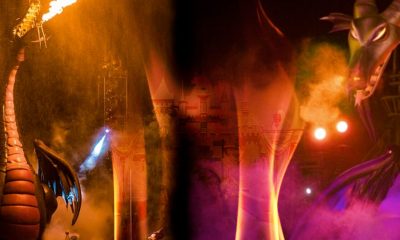

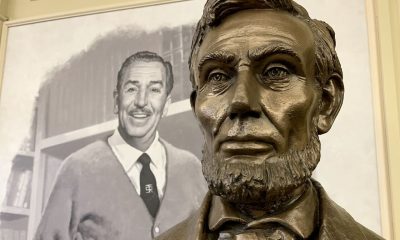

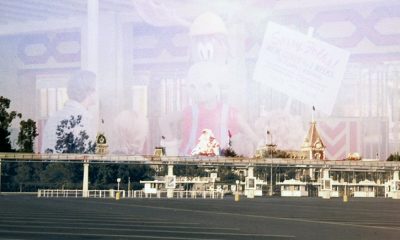

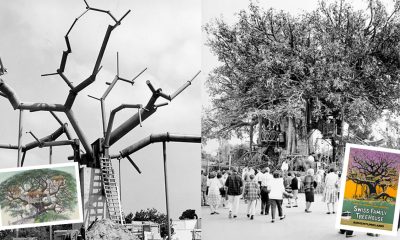























Jenna Orteca
March 28, 2024 at 4:22 am
That was so great movies series I ever ever see in my life.